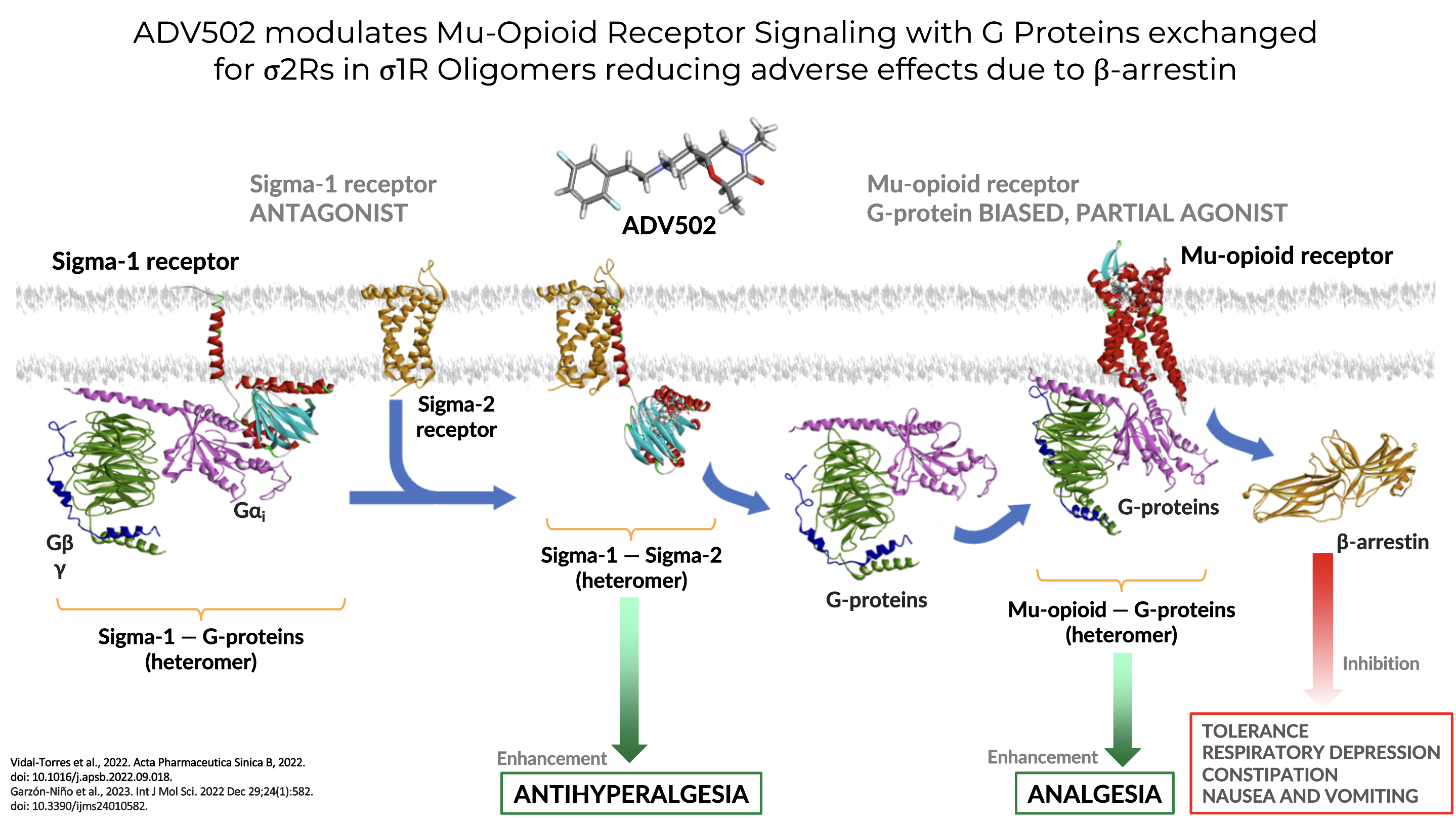ADV502-PSUD for Polysubstance Use Disorder:
- First-in-class Sigma1 antagonist + MOR partial agonist
- Innovative design
- High Selectivity
- Oral monotherapy
- Positive results on Clinical PhaseI
Mechanism of Action on Polysubstance Use Disorder
ADV502 has been designed to synergistically enhance MOR-mediated analgesia reducing opioid-related adverse effects including morphine analgesic tolerance, physical dependence, hyperlocomotion, or mydriasis.
Neuropathic cancer pain (NCP) is a devastating condition caused by either the damage the peripheral or central nervous system from cancer itself and/or treatments including chemotherapy, radiotherapy, and surgery.
Sigma1-receptor has strong effects on pain signal transduction by interacting with various protein partners, including MORs, NMDARs, and CB1Rs. s1R antagonists modulate the chaperoning activity of s1Rs by amplifying opioid signaling and diminishing NMDAR responses, consequently potentiating opioid analgesia and recovering from the sensory hypersensitivity that features “disease-specific” (pathological) pain conditions.
The potentiation of opioid anti-nociception of ADV502 in NCP by s1R inhibition is not followed by the worsening of opioid-related unwanted effects including tolerance, addiction, or constipation, so the concomitant administration of s1R antagonists improves the therapeutic window of MOR.
Pain signaled by the trigeminal nociceptors is often debilitating, especially in Neuropathic Cancer Pain, and includes musculoskeletal pain and neurovascular disorders.
Sigma-1 receptor antagonist modulates trigeminal nociceptors that have cell bodies in the trigeminal ganglia and send nociceptive sensory input to the central nervous system.
Learn more
A new and safer analgesic
The development of new and safer analgesics with innovative mechanisms of action, which can enhance the efficacy in comparison to available treatments and reduce their side effects, including the development of tolerance, addiction, constipation, and life-threatening respiratory depression associated to opioids, is urgently needed.
The sigma-1 receptor (σ1R), a unique Ca2+-sensing chaperone protein, is expressed throughout pain-modulating tissues and affects neurotransmission by interacting with different protein partners, including molecular targets that participate in nociceptive signalling, such as the μ-opioid receptor (MOR), N-methyl-d-aspartate receptor (NMDAR) and cannabinoid 1 receptor (CB1R). Overwhelming pharmacological and genetic evidence indicates that σ1R antagonists induce anti-hypersensitive effects in sensitizing pain conditions (e.g. chemically induced, inflammatory and neuropathic pain) and enhance opioid analgesia but not opioid-mediated detrimental effects.
It has been suggested that balanced modulation of MORs and σ1Rs may improve both the therapeutic efficacy and safety of opioids.
Dual MOR agonism/σ1R antagonism represents a promising avenue for the development of potent and safer analgesics.
Preclinical validation completed.
- Acute mechanical and thermal nociception: Acute dose-response (p.o.)
ADV502 exerts antinociceptive effects in mice in tests that are sensitive to mu-opioid agonists

- Neuropathic pain induced by partial sciatic nerve ligation (PSNL): Acute dose-response (p.o.)
ADV502 exerts an antiallodynic action in mice within 15 minutes.

Preparing a Phase 2 study to evaluate the efficacy of ADV502 administered orally at doses of 2.5 mg QID in a cohort of cancer patients affected by severe drug-resistant neuropathic pain.

